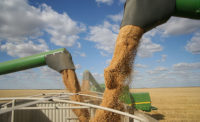Business Strategies | 2020 Crop Report
2020 Crop Report: Buyer’s market, despite uncertainty

Feed ingredients are the No. 1 cost component of the protein business, followed by labor and energy. Oil prices are historically linked to feed-ingredient crops. A significant percentage of the corn and soybean crops are used in ethanol and bio-diesel production. History tells us the feed-ingredient markets are a game of speculation until we get to the final harvest numbers. We are all trying to determine what will really happen and evidence helps to predict that. Every year I do my best to help you predict the future to make the best business decision. Corn and soybeans are the key crops in feed ingredients for the protein industry in the United States. Wheat is a smaller player.
The 2020 growing season was delayed by an extended winter and wet planting season in 2019. Because of last year’s extremely wet spring, many farmers were unable to plant their crops until late June to mid-July. This resulted in a reduction in yield. Many crops did not get harvested before the first snow/freezing event. As a result, many acres were harvested in the spring of 2020 before planting could occur. This may result in some reduction of acres planted. A warm May, lots of moisture and near-perfect June weather leading up to July 1 in most growing regions may accelerate growth and yield. It will be a buyer’s market regardless of how it shakes out. As usual, there are pockets of drought but nothing that will have a significant impact on either the corn or soybeans supply.
We are still in a trade war with China, and that nation is becoming increasingly undersupplied. It’s likely it will be forced to buy U.S. corn, soybeans, pork and chicken to supplement supplies it has been purchasing from around the world. China has committed to buying an additional $200 billion worth of American goods and services by 2021 and is expected to ease some of the tariffs it has placed on American products. A cornerstone of its purchases will be in the U.S. agriculture segment. But the agreement preserves the bulk of the tariffs President Donald Trump has placed on $360 billion worth of Chinese goods, and it maintains the threat of additional punishment if Beijing does not live up to the terms of the deal.
Oil prices and feed-ingredient prices consistently travel together in price charts. This is a component of the significant percentage of the corn and soybean crop in ethanol and bio-diesel production. This year may go under the anomaly of all anomalies. We have COVID-19 turning the energy market upside down. At one point, oil price futures were in the negative category, caused by a severe drop in energy consumption because of stay-at-home orders and buildings and businesses shutting down. By April, 35 percent of U.S. ethanol plants had fully idled and many others had reduced production. There was so much supply that storage capacity worldwide was full. Last year, the ethanol industry produced about 38 million metric tons of distiller’s grains in 2019, but because of COVID-19 and reduced ethanol demand, the current volume is on pace to be roughly 19 million metric tons in 2020. The availability of dried distiller’s grains with solubles (DDGS), an ethanol byproduct and a critical animal feed ingredient, has corresponded with the decline. DDGS shortages have forced feed manufacturers to secure alternative ingredients and reformulate their rations, which typically results in higher feed costs.
Seed hybrids biotech varieties (92 percent of corn and 94 percent of soybeans), planting technology, herbicides, fungicides, seed treatments, satellite monitoring and many other advancements have made farming infinitely more productive in terms of harvested bushels per acre.
The U.S. Department of Agriculture’s National Agricultural Statistics Service (NASS) on June 30 estimated 92.0 million acres of corn planted in the U.S. for 2020, up 3 percent from last year, according to the Acreage report. Soybean area planted is estimated at 83.8 million acres, up 10 percent from last year.
Following up on the Prospective Plantings report released in late spring, NASS surveyed nearly 71,000 farm operators during the first two weeks of June to gather information on what farmers actually planted. Key findings released in the Acreage report include
Corn
- Growers expect to harvest 84 million acres of corn for grain, up 3 percent from last year.
- 92 percent of all corn acres planted in the U.S. are biotech varieties, unchanged from last year.
Soybeans
- Harvested area for 2020 is estimated at 83 million acres, up 11 percent from 2019.
- Producers planted 94 percent of the soybean acreage using herbicide-resistant seed varieties, unchanged from 2019.
Wheat
- Planted area for 2020 is estimated at 44.3 million acres, down 2 percent from last year. This represents the lowest wheat planted area on record since records began in 1919.
- Winter wheat planted area is estimated at 30.6 million acres, down 2 percent from 2019. This represents the second-lowest winter wheat planted area on record since records began in 1909.
- Other spring wheat planted area is estimated at 12.2 million acres, down 4 percent from 2019.
- Durum wheat planted area is estimated at 1.50 million acres, up 12 percent from last year. This marks the first year of increasing acreage since 2016.
NASS also released the quarterly Grain Stocks report to provide estimates of on-farm and off-farm stocks as of June 1. Key findings in that report include:
Grain Stocks
- Corn stocks totaled 5.22 billion bushels, up less than 1 percent from the same time last year. On-farm corn stocks were up 3 percent from a year ago, but off-farm stocks were down 2 percent.
- Soybeans stored totaled 1.39 billion bushels, down 22 percent from June 1, 2019. On-farm soybean stocks were down 13 percent from a year ago, while off-farm stocks were down 28 percent.
- All wheat stored totaled 1.04 billion bushels, down 3 percent from a year ago. On-farm all wheat stocks were up 12 percent from last year, while off-farm stocks were down 7 percent.
- Durum wheat stored totaled 42.8 million bushels, down 22 percent from June 1, 2019. On-farm stocks of Durum wheat were down 32 percent from June 1, 2019. Off-farm stocks of Durum wheat were down from the previous year by 13 percent.
Every year is unique and the variables in play can cause unforeseen changes. My recommendation is to hedge on a low market while corn and soybeans are oversupplied. Continued uncertainty over the coronavirus’ resurgence continues to take a toll on the many sectors globally. NP
Looking for a reprint of this article?
From high-res PDFs to custom plaques, order your copy today!






